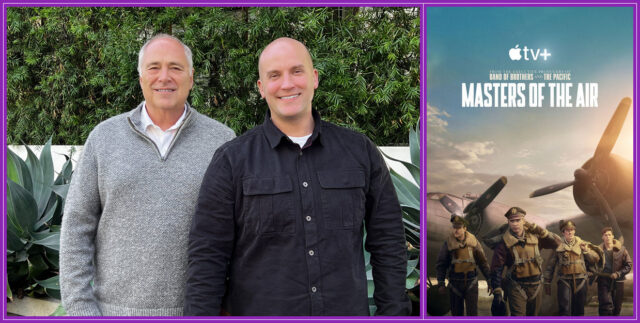
An exclusive in-depth interview with Formosa Group sound gurus, Supervising Sound Editor JACK WHITTAKER and Re-Recording Mixer and Supervising Sound Editor MICHAEL MINKLER, discussing the soundscape and sonic experience of MASTERS OF THE AIR.
SYNOPSIS: Based on Donald L. Miller’s book of the same name, and scripted by John Orloff, “Masters of the Air” follows the men of the 100th Bomb Group (the “Bloody Hundredth”) as they conduct perilous bombing raids over Nazi Germany and grapple with the frigid conditions, lack of oxygen and sheer terror of combat conducted at 25,000 feet in the air. Portraying the psychological and emotional price paid by these young men as they helped destroy the horror of Hitler’s Third Reich, is at the heart of “Masters of the Air.” Some were shot down and captured; some were wounded or killed. And some were lucky enough to make it home. Regardless of individual fate, a toll was exacted on them all.
Always exciting to speak with any of the sound artisans at Formosa Group, it’s particularly engaging and interesting when speaking with legends like Emmy-winner JACK WHITTAKER and three-time Oscar-winner MICHAEL MINKLER about a production like MASTERS OF THE AIR.
MASTERS OF THE AIR is a production that for a large part of the series, falls to the sound design, mixing, and editing to capture the emotionality of the story and each of the men we meet and bring that to life. Much of the events take place within the confines of the B17. We rely on the sound to convey the feelings of each man on the plane, be it the pilot or co-pilot, or any of the other eight manned positions in the bomber; to wit, bombadier, radio operator/gunner, navigator, top turret gunner/engineer, ball turret gunner, right waist gunner, left waist gunner, and tail gunner. They communicate through radio headsets within the bomber and unlike modern aircraft, also combat the sound of winds and windshear, as well as the sounds of the German fighter planes, the Messerschmidt and FW190 and more. So exacting is the sound on MASTERS OF THE AIR that we even hear the click of mics, switches, radios, and intercoms as they are turned on or off. Adding to the sonic cacophony is the communication with other aircraft in the sky, also with multiple individuals manning the planes.
The raw adrenaline-fueled emotion of each man entering into aerial battles or bombing missions must be conveyed with breath, yelling, crying, etc., so that we feel the urgency, the tension, and the fear that the real-life heroes felt during WWII. And not just while in the air, but on the ground as well. Bearing in mind the technology back in the day, the Formosa sound team had to capture and create the sound with authenticity and with clarity. And this is all just in the air. Then there are the moments on the ground with everything from the joys of camaraderie in hoisting a few drinks after a successful mission to sounds in the heat of ground battle and bombing or during a solemn death march or a single man walking in silence into a burned-out concentration camp. These are all sonic elements that require exemplary skills and collaboration. Jack and Michael and their team deliver award-worthy work on every level.
In this exclusive interview with JACK WHITTAKER and MICHAEL MINKLER, the gentlemen discussed the overall sound design and mixing process for a historical drama series, focusing on capturing the authenticity of the era through period-specific sound elements. Sharing their strategies for creating an immersive audio experience, Jack and Michael went deep into multiple sonic elements, among them:
- the importance of emotional authenticity and attention to detail
- the challenges of balancing dialogue, music, and sound effects
- the importance of precision in creating a cohesive soundscape
- the process of creating the soundscape for film, including recording in a B17 plane in Arizona
- recreating dialogue and communication using recreation and vocal editing
- audio production techniques for historical dramas
- developing ground swell audio; differentiating between battles and locales
- the emotional arc of prisoners in concentration camps and capturing that with sound
- creating multiple groups of sounds for air attacks, hundreds of backgrounds
- the fluidity of music, sound effects and dialogue in the mixing process
- the challenges of balancing dialogue and music for emotional impact
- the challenges of keeping the plane “alive” and involving the audience with the engine sounds
- heightening the emotional experience through sound
- using Donald L. Miller’s book “Masters of the Air” for emotional reference points with sound
- and more!
TAKE A LISTEN. . .
by debbie elias, exclusive interview 04/05/2024
MASTERS OF THE AIR is streaming on AppleTV+.












